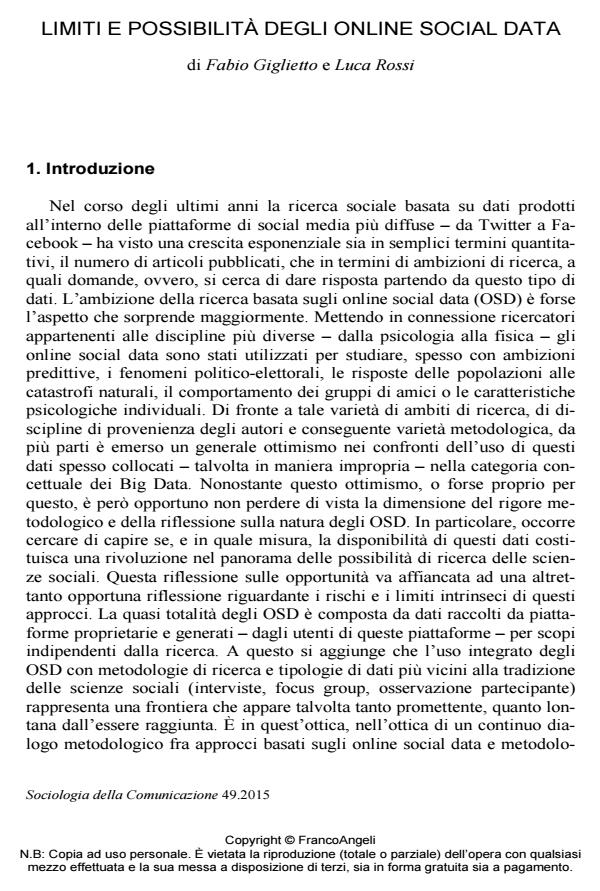Limits and possibilities of online social data
Journal title SOCIOLOGIA DELLA COMUNICAZIONE
Author/s Fabio Giglietto, Luca Rossi
Publishing Year 2015 Issue 2015/49 Language Italian
Pages 10 P. 9-18 File size 148 KB
DOI 10.3280/SC2015-049002
DOI is like a bar code for intellectual property: to have more infomation
click here
Below, you can see the article first page
If you want to buy this article in PDF format, you can do it, following the instructions to buy download credits

FrancoAngeli is member of Publishers International Linking Association, Inc (PILA), a not-for-profit association which run the CrossRef service enabling links to and from online scholarly content.
The shift of several everyday activities to digital platforms have brought, among many other changes, an extraordinary availability of data for social scientists. On the one hands this richness opens new opportunities, on the other it poses new challenges. The skills required to analyze large quantity of data, the relationship between quantity and quality and the one between researcher and the private platforms where the data are created and stored are only some example of the open issues addressed in this paper.
Keywords: Online data, Twitter, computational social science
- Bruns A., Highfield T., Burgess J. (2013), The Arab Spring and Social Media Audiences: English and Arabic Twitter Users and Their Networks, «American Behavioral Scientist», vol. 57, n. 7, pp. 871-898. DOI: 10.1177/0002764213479374
- Bucher T. (2013), Objects of intense feeling: The case of the Twitter APIs, «Computational Culture», 3.
- Burgess J. (2014), From ‘Broadcast yourself’to ‘Follow your interests’: Making over social media, «International Journal of Cultural Studies», 1367877913513684.
- Burgess J., Bruns A. (2015, December 8), Easy Data, Hard Data: The Politics and Pragmatics of Twitter Research after the Computational Turn. Compromised Data: From Social Media to Big Data, Bloomsbury, London.
- Caldarelli G., Chessa A., Pammolli F., Pompa G., Puliga M., Riccaboni M., Riotta G. (2014), A multi-level geographical study of Italian political elections from Twitter data, «PloS One», vol. 9, n. 5, e95809. DOI: 10.1371/journal.pone.0095809
- Huberman B. A., Romero D. M., Wu F. (2009), Social Network that matter: Twitter under the microscope, «First Monday», vol. 14, n. 1.
- Java A., Song X., Finin T., Tseng B. (2007), Why We Twitter : Understanding Microblogging. Network 1, ACM Press, pp. 56-65.
- Larsson A. O., Moe H. (2011), Studying political microblogging: Twitter users in the 2010 Swedish election campaign, «New Media & Society», vol. 14, n. 5, pp. 729-747. DOI: 10.1177/1461444811422894
- Liu Y., Kliman-Silver C., Mislove A. (2014, May). The tweets they are achangin’: Evolution of twitter users and behavior. In International AAAI Conference on Weblogs and Social Media (ICWSM) (Vol. 13, p. 55). Mocanu D., Baronchelli A., Perra N., Gonçalves B., Zhang Q., Vespignani A. (2013), The Twitter of Babel: mapping world languages through microblogging platforms, «PloS One», vol. 8, n. 4, e61981. DOI: 10.1371/journal.pone.0061981
- Morstatter F., Pfeffer J., Liu H., Carley K. M. (2013). Is the sample good enough? Comparing data from Twitter’s streaming API with twitter’s firehose. Proceedings of ICWSM.
- PEW Research center (2014), Social Networking Fact Sheet, http://www.pewinternet.org/fact-sheets/social-networking-fact-sheet/ Washington, D.C. (Accessed on Feb. 23, 2015).
- Twitter (2015), Twitter Usage, https://about.twitter.com/company (Accessed on Feb. 23, 2015).
- Van Dijck J. (2013), The culture of connectivity: A critical history of social media, Oxford University Press.
- Vis F. (2013), A critical reflection on Big Data: Considering APIs, researchers and tools as data makers, «First Monday», vol. 18, n. 10.
Fabio Giglietto, Luca Rossi, Limiti e possibilità degli online social data in "SOCIOLOGIA DELLA COMUNICAZIONE " 49/2015, pp 9-18, DOI: 10.3280/SC2015-049002